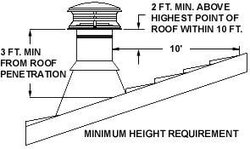Hi,
My husband and I are getting a new wood stove tomorrow. We are buying a Vermont Castings Resolute Acclaim (the floor model). We are also buying a hearth pad in Vermont Black Slate from the dealer. We are installing the stove ourselves in the living room. The house does not have a pre-existing chimney, fireplace or wood stove.... we are starting from scratch! The living room has a cathedral ceiling, so we will be installing stove pipe up the first 10 feet, then switching to the expensive chimney pipe and going through the roof. We were thinking about getting one of those chimney kits from Lowes. We're pretty young and fearless, so I'm sure everything will be fine. I am also a safety NUT!! Does anyone have any advise on pretty much anything at all? Is there a good website that has instructions on how to install the chimney? Do I need to do something special since it is a cathedral ceiling and we won't be going through the attic? We live in Holbrook, MA (South of Boston). Any good places to get wood or better places to get the chimney materials? Thanks in advance!
Maplegirl
My husband and I are getting a new wood stove tomorrow. We are buying a Vermont Castings Resolute Acclaim (the floor model). We are also buying a hearth pad in Vermont Black Slate from the dealer. We are installing the stove ourselves in the living room. The house does not have a pre-existing chimney, fireplace or wood stove.... we are starting from scratch! The living room has a cathedral ceiling, so we will be installing stove pipe up the first 10 feet, then switching to the expensive chimney pipe and going through the roof. We were thinking about getting one of those chimney kits from Lowes. We're pretty young and fearless, so I'm sure everything will be fine. I am also a safety NUT!! Does anyone have any advise on pretty much anything at all? Is there a good website that has instructions on how to install the chimney? Do I need to do something special since it is a cathedral ceiling and we won't be going through the attic? We live in Holbrook, MA (South of Boston). Any good places to get wood or better places to get the chimney materials? Thanks in advance!
Maplegirl


 )?
)?
